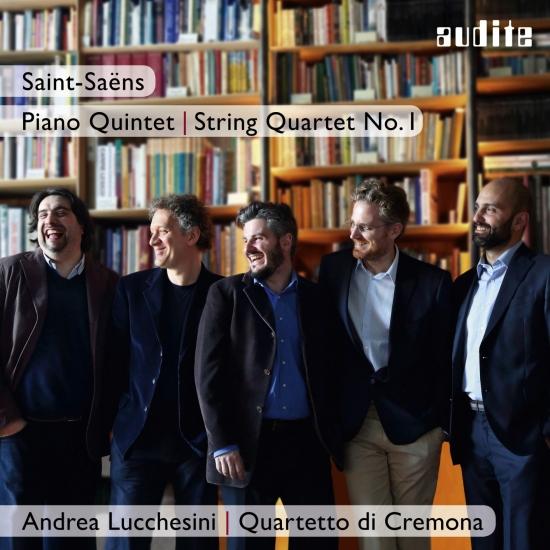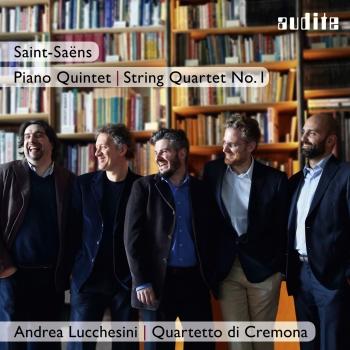
Saint-Saëns: Piano Quintet & String Quartet No. 1 Andrea Lucchesini & Quartetto di Cremona
Album info
Album-Release:
2016
HRA-Release:
04.08.2017
Label: audite Musikproduktion
Genre: Classical
Subgenre: Chamber Music
Artist: Andrea Lucchesini & Quartetto di Cremona
Composer: Camille Saint-Saëns (1835-1921)
Album including Album cover Booklet (PDF)
- Camille Saint-Saëns (1835 - 1921): Piano Quintet & String Quartet No. 1:
- 1Piano Quintet in A Minor, Op. 14: I. Allegro moderato e Maestoso10:23
- 2Piano Quintet in A Minor, Op. 14: II. Andante Sostenuto07:26
- 3Piano Quintet in A Minor, Op. 14: III. Presto04:38
- 4Piano Quintet in A Minor, Op. 14: IV. Allegro assai, ma Tranquillo08:48
- 5String Quartet No. 1 in E Minor, Op. 112: I. Allegro11:28
- 6String Quartet No. 1 in E Minor, Op. 112: II. Molto allegro quasi Presto05:46
- 7String Quartet No. 1 in E Minor, Op. 112: III. Molto Adagio08:37
- 8String Quartet No. 1 in E Minor, Op. 112: IV. Allegro non Troppo06:24
Info for Saint-Saëns: Piano Quintet & String Quartet No. 1
Die beiden Kammermusik-Werke stehen für die frühe Vollendung und für den expressiv-klassizistischen Spätstil von Camille Saint-Saëns. Brillanz und untrüglichen Formsinn, melancholisch-ruhiges Verweilen und energischer Zugriff, romantische Sanglichkeit und erlesene Kompositionskunst – die Kontraste, die Saint-Saëns’ Tonsprache ausmachen, bringt das Quartetto di Cremona musikalisch perfekt zur Geltung.
Sechs Italiener und ein Franzose: Saint-Saëns' kontrastreiche Tonsprache in Vollendung
Das vielfach preisgekrönte Quartetto di Cremona bringt die ganze Erfahrung einer sechzehnjährigen Konzert- und Aufnahmetätigkeit in seine neueste CD mit Kompositionen von Camille Saint-Saëns ein. Andrea Lucchesini, einer der führenden italienischen Pianisten der Gegenwart, erweitert im Klavierquintett die Quartettformation in der prominenten Rolle des Klavierpartners. Der dritte Satz des Werks wird in der selten dargebotenen Form mit Kontrabass (ad lib.) präsentiert.
Die zwei Kammermusikwerke des französischen Komponisten stehen für wesentliche Phasen seines Schaffens: Das Klavierquintett, ein Werk der frühen Vollendung, zeigt deutlich die Auseinandersetzung mit der deutschen Romantik, insbesondere mit Robert Schumann und seiner Formensprache. Im ersten Streichquartett, das den Übergang in den Spätstil markiert, verzichtete Saint-Saëns erstmals in der Kammermusik auf sein Instrument, das Klavier. Seine Art des Klassizismus - klar in den Formen, farbig im Ausdrucksspektrum - tritt hier besonders deutlich hervor. Brillanz und untrüglichen Formsinn, melancholisch-ruhiges Verweilen und energischer Zugriff, romantische Sanglichkeit und erlesene Kompositionskunst - die Kontraste, die Saint-Saëns' Tonsprache ausmachen, bringt das Quartetto di Cremona musikalisch perfekt zur Geltung.
„Ein Plädoyer für den Kammermusiker Saint-Saëns.“ (Fono Forum
Andrea Lucchesini, Klavier
Quartetto Di Cremona
Andrea Lucchesini
Trained under the guidance of Maria Tipo, Andrea Lucchesini garnered international recognition at a very young age when he won the "Dino Ciani" International Competition at the Teatro alla Scala in Milan. Since then he has performed throughout the world with leading orchestras, working with conductors such as Claudio Abbado, Semyon Bychkov, Roberto Abbado, Riccardo Chailly, Dennis Russell Davies, Charles Dutoit, Daniele Gatti, Gabriele Ferro, Gianluigi Gelmetti, Daniel Harding, Vladimir Jurowski, Gianandrea Noseda and Giuseppe Sinopoli.
In December 2015 he returned to Teatro La Scala with Beethoven's Choral Fantasy, under the baton of Franz Welser Moest
His wide-ranging activities, marked by a desire to explore music with no limitations, lead him to offer programs ranging from classical to current repertoire. In 1994 this earned him the recognition of European musicologists from which he received the Accademia Chigiana International Prize (the only Italian honoured so far). The following year he won the F. Abbiati Prize, which confirmed the appreciation of the Italian critics.
Lucchesini has made several recordings, the first few of which date back to the 1980s for EMI International (Liszt's Sonata in B minor, Beethoven's Sonata op.106 Hammerklavier and Chopin’s Sonata op.58). He then recorded Schoenberg’s Pierrot Lunaire and Berg's Chamber Concerto for Teldec with the Dresden Staatskapelle conducted by Giuseppe Sinopoli.
For BMG the pianist recorded Luciano Berio’s Concerto Echoing Curves, conducted by the composer himself. This marked one of the milestones of a close collaboration with Berio, with whom Lucchesini witnessed the creation of the composer’s final and challenging work for solo piano, Sonata. Lucchesini performed the world premiere of this piece in 2001 which - together with all of Berio’s other piano works - became part of a CD for AVIE Records, which met with unanimous international critical acclaim.
Equally appreciated is Lucchesini’s live recording of Beethoven’s complete cycle 32 sonatas for Stradivarius. The collective work obtained the recognition of "CD of the month" by the prestigious German magazine “Fonoforum” in August, 2004.
His most recent recording, the Schubert Impromptus made for AVIE Records, received an enthusiastic response from critics worldwide.
in 2017 Andrea Luccheisni appears at Maggio Musicale Fiorentino under the baton of Fabio Luisi, in Roma with Santa Cecilia Orchestra and Wyung Whun Chung and in Torino with the RAI Symphony Orchestra conducted by Dennis Russel Davies.
Since 1990, the pianist has dedicated his attention to chamber music as well, including in particular a close collaboration (performing and recording) with cellist Mario Brunello and Quartetto di Cremona, and exploring various formations in chamber music repertoire.
Convinced that imparting musical knowledge to the younger generations is a moral duty, Lucchesini is passionately dedicated to teaching. He currently teaches at the Scuola di Musica di Fiesole, where he has been artistic director from 2008 till 2016. He is frequently invited to hold masterclasses at major music institutions in Europe, such as the Musik Hochschule in Hannover and the Sommer Wasserbuger Festspiele and Musik Hochschule in Salzburg and in New York.
He serves on juries at numerous piano competitions all over the world and was named Accademico of Santa Cecilia in 2008.











